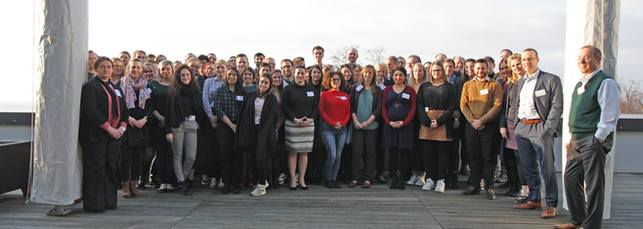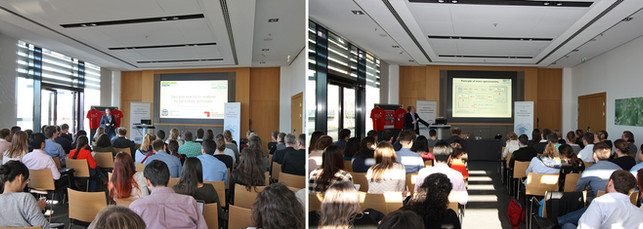
Dr. Heidi Noels and Dr. Yvonne Döring receive the W.H. Hauss Award from the DGAF
19-21 April 2018
Dr. Heidi Noels from the Institute for Molecular Cardiovascular Research at RWTH Aachen University together with Dr. Yvonne Döring from the Institute for Prophylaxis and Epidemiology of Circulatory Diseases at LMU Munich together received the DGAF W.H. Hauss Award 2018 from the German Society for Atherosclerosis Research (DGAF) during the 32nd Annual Meeting of the DGAF in Rauischholzhausen, Germany. They were awarded for their publication "Vascular CXCR4 Limits Atherosclerosis by Maintaining Arterial Integrity: Evidence From Mouse and Human Studies." (Circulation. 2017; 136: 388-403). In this work it could be shown that vascular CXCR4 has an atheroprotective function by maintaining the arterial integrity and preserving the endothelial barrier function. In addition, CXCR4 stabilizes a contractile smooth muscle cell phenotype. Targeted enhancement of these CXCR4-mediated protective functions could open up novel therapeutic options in the treatment of atherosclerosis.
The award was sponsored by a long-standing active member of the DGAF, Prof. Dr. Winfried März.
Project area Z
Administrative project
Robert Werner Mertens
MD student
University Hospital RWTH Aachen
Department of Internal Medicine
Project: The role of incretin hormone GLP-2 in septic cardiomyopathy
PI: Michael Lehrke
Robert Werner Mertens
MD student
University Hospital RWTH Aachen
Department of Internal Medicine
Project: The role of incretin hormone GLP-2 in septic cardiomyopathy
PI: Michael Lehrke
Consortium


Mechanisms of Cardiovascular Complications
in Chronic Kidney Disease
The SFB/TRR219 is supported by the German Research Foundation (DFG)
Project-ID 322900939
Johnny.Decimal - a system to organize your life (#4)
This letter guides readers through the systematic approach of Johnny.decimal, offering practical steps to implement this organizational method effectively. By exploring the advantages, starting steps, and additional resources provided, readers will gain valuable insights into structuring and managing their data with clarity and efficiency.

Introduction
Finding the right data can sometimes feel like archaeology—digging deep into uncharted territories, sifting through clues, and evaluating whether what you've uncovered is truly what you seek. When dealing with unstructured data, it's similar to navigating through rugged landscapes with few clues. But applying context and systematic rules can make data retrieval more efficient and informative. Introducing Johnny.decimal—a structured approach designed to bring order and efficiency to the chaos of unstructured data. It offers a unique method for organizing information with a clear and hierarchical framework.
Advantages
-
Structured Hierarchy: By breaking down data into a decimal-based structure, Johnny.decimal provides a clear and organized hierarchy, allowing for easy navigation and retrieval of information.
-
Efficient Categorization: With a limited set of categories and subcategories (0-9), Johnny.decimal simplifies the process of organizing diverse types of data without overwhelming complexity.
-
Scalability and Flexibility: The system can adapt to various projects and contexts, making it suitable for personal and professional use alike.
How to start
Imagine your computer as a physical storage space. We can’t put everything on the floor, so we buy some shelves. Just like we can't scatter everything on the floor, we organize with shelves. If we had an endless number of shelves, finding anything would be impossible. So, we stick with ten. We assign each shelf to a specific area of our life: one for life administration, another for home business, and yet another for our music hobby. Notice that we don't have to fill all ten shelves right away. There's space to expand as needed.
Each shelf contains space for ten boxes. We decide how to categorize the things we're going to store. For life administration, we might use boxes for finance, health, house, education, technology, and travel.
Your categories might be different. Maybe you own a car, or have kids. You design your system to suit your life. Our boxes have space for a number, so we label everything neatly.
This is exactly how your file will look:
To build your own Johnny.decimal system, follow these steps:
-
Break Everything Down: Divide your data into no more than ten main areas and further categorize each area into no more than ten subcategories.
-
Assign numbers: assign numbers to those areas and categories.
-
Create Items and IDs: Begin assigning Johnny.decimal IDs to items within your structured framework.
-
Track Your System: Keep a record of your numbers and IDs to ensure consistency and ease of reference.
It isn’t much more complicated than that.
For a quick overview of Johnny.decimal's concept, watch this 1-minute video: Video Link
Advice: don’t rush the process. Take the time to understand the scope of your organizational needs and recognize patterns before finalizing your categories.
Useful links
1) For more information and detailed guidance on Johnny.decimal, visit Johnny.Decimal Website or explore the methodology in video format on YouTube.
2) Create your own structured data system with the Johnny.Decimal Index Generator, an interactive tool designed to simplify the process of organizing information.




Disclaimer
I hope this was an interesting read. If you have comments, remarks, or suggestions about other RDM-related topics for the next newsletters, please let me know by sending me an email at dukkart@itc.rwth-aachen.de.
Image designed by stories / Freepik, and johnnydecimal.com











